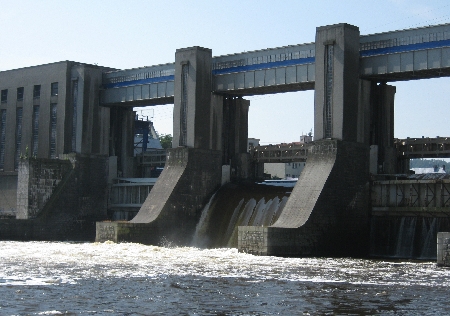
Dam and Hydro-electric plant on the Vltava at Vrané © Ricky Yates
As most people who know me will already be aware, I have had a lifelong interest in canals and inland waterways. I was therefore delighted to discover that the Vltava, the river on which Prague is situated, is navigable. Engineering works, begun in the nineteenth century, have provided locks, navigable cuts and a sufficient depth of water to allow quite sizeable craft to reach the city.
The Vltava (or Moldau in German) leaves the Labe (Elbe in German) at Melnik, about 50 km north of Prague. From Melnik, it is possible to travel downstream along the Labe/Elbe all the way to the North Sea at Hamburg as well as connecting with canals and rivers that lead to Berlin and other German cities. Upstream of Melnik, the Labe is also navigable as far as the Czech city of Pardubice.
Not only is the Vltava navigable, it still carries quite a considerable amount of commercial traffic as far as Prague. From my observations, this mainly consists of bulky materials such as sand and gravel. The use of river transport in this way saves the surrounding roads from a large number of additional truck journeys which would otherwise be required to shift these goods.
In the centre of Prague, the Vltava is populated by many passenger vessels offering tourists trips along the river to view the city sights or to enjoy a meal in a floating restaurant. Most of these vessels rarely pass a lock, confining themselves to the section of the river between Hlávkuv most (just east of St. Clement’s Church) and to just south of Karluv most (Charles Bridge). However, a few months ago, I was delighted to discover that one company does offer a far longer trip upstream on the Vltava, all the way to the head of navigation at Slapy, nearly 40 km south of Prague city centre.
Pražská Paroplavební Spolecnost only run this trip on Saturdays and Sundays between early May and mid September. As Sundays are out because of my profession, if I was going to make the trip this summer, it was going to have to be on a Saturday. And having my sister Jenny staying with us for ten days recently gave me the perfect excuse. Here was a day out that we would both enjoy! So having for once, completed the Sunday sermon on Friday, on Saturday 15th August we set out early from the flat, travelled by bus and metro to Palackého námestí, bought our tickets from the office on the quayside, all ready for our departure upstream at 9am.
The boat was smaller than I was expecting and was quite packed with standing room only. However, so far as I was aware, Jenny and I were the only non-Czechs on board. This trip clearly appeals to Czech people who want to head out of Prague into the surrounding countryside but clearly doesn’t normally appear on the agenda of visiting foreign tourists.
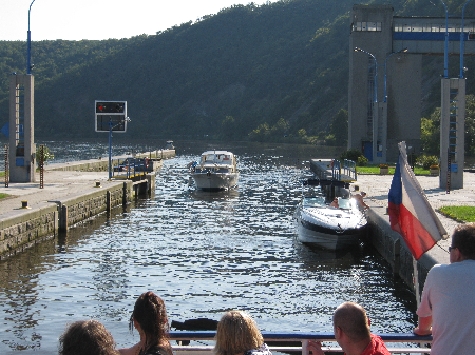
Small pleasure boats entering lock at Vrané © Ricky Yates
The initial part of the journey out of Prague goes past the Staropramen Brewery on one side of the river and the twin spires of the Church of St. Peter & St.Paul at Vyšehrad on the other. Then follows the southern suburbs of the city, together with passing our first lock at Modrany. Soon afterwards comes the confluence of the River Berounka and then the Vltava enters an ever increasingly beautiful wooded valley at Zbraslav.
About 5 km further on lies the next lock at Vrané. This is situated at one side of a fairly substantial dam built across the river to generate hydro-electric power. Beyond this dam and lock, the river is wider because it is effectively a ribbon lake.
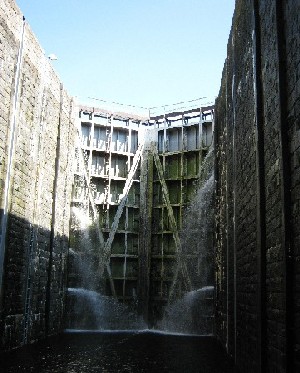 Inside Štechovice Lock © Ricky Yates |
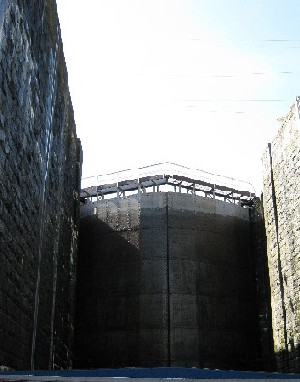 Lower gates of Štechovice Lock © Ricky Yates |
After cruising for over three hours and nearly 30 km, we arrived at the town of Štechovice. Here passengers both got off and on before we set out on the final leg of the journey. Ahead lay a much higher dam, also generating hydro-electricity, and therefore with a far deeper lock alongside. In fact the lock is monstrous – certainly the deepest lock I’ve ever passed through. The mind boggles as to how much water it takes to fill it! But eventually, our boat rose out of the bowels of the lock for a further forty minutes of cruising past beautiful wooded hills until we reached journeys end, the quay at Nové Trebenice, immediately below the very impressive Slapy Dam.
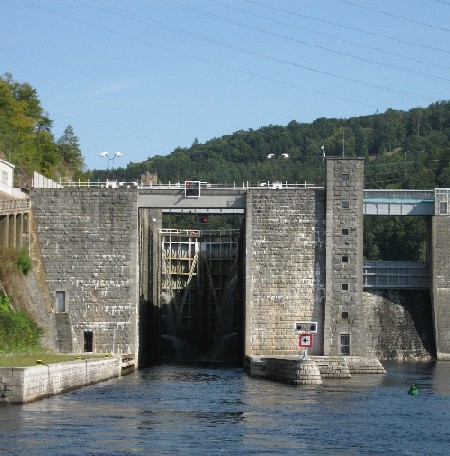
Štechovice Lock © Ricky Yates
The Slapy Dam was built during the Communist era between 1949 – 1955. Like the earlier smaller dams we passed, it also enables the generation of hydro-electricity as well as helping to control the river flow, hopefully helping to prevent flooding further downstream during times of heavy rainfall. But for unknown reasons, no lock or boat lift was provided when it was built and the dam therefore prevents through navigation. The lake behind the dam is extremely popular with small yachts and pleasure boats. But none of them can cruise down the river to Prague because the Slapy Dam blocks the way.
After a quick lunch at a bar-restaurant in Nové Trebenice and a walk out on top of the dam, it was back to the boat for the return journey. This was fortunately less crowded as a number of people only did the journey one-way and got the bus back to Prague. It thus enabled me to more easily take the photographs that accompany this post. We arrived back at the quay alongside Palackého námestí at 6.30pm somewhat tired and a little sunburnt but having had a most enjoyable day.
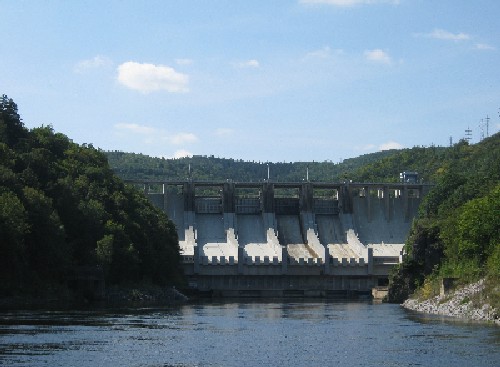
Slapy Dam © Ricky Yates
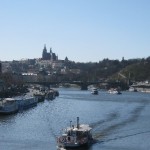
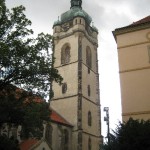




What an interesting trip! I’ve never heard of this. I love locks and dams because they represent science and engineering I can understand. I love to stand in front of working museum models of locks and dams and watch them go. I must say though, I’m waiting for a female civil engineer to come along and make dams prettier. They’re always so concrete and Soviet-looking. Why can’t they be engineered to have hanging gardens, for example, on the downstream side like a container pot? It would be practically self-watering.
P.S. The communists probably didn’t put a lock in that dam because that would have been human and fun.
Hi Karen – The trip isn’t as well advertised as it could be though clearly many Czechs know about it as the boat was quite crowded. You can follow the link to the website of the trip boat company from my post. I agree with you that some of the engineering and construction is a bit utilitarian but quite impressive none the less.
Why the Communists didn’t provide a lock or boat lift at the Slapy Dam is quite beyond me as they were not anti freight transport by water. I did find a piece on one website (which I now cannot locate) saying that there is a long-term plan to build a boat lift at Slapy & at another dam higher up the Vltava and make a through navigation all the way to Ceske Budejovice (sorry that has the hacheks missing!)
You should check out Tomáš Ba?a’s celebrated canal, the initial phase of long-planned but never realized Danube-Oder-Canal (to quote the Wikipedia article at http://en.wikipedia.org/wiki/Ba?a_Canal, which runs through Moravia.
It’s always fatal to use diacritics in such situations: http://en.wikipedia.org/wiki/Bata_Canal, and I was referring to footwear magnate and creator of modern Zlin, Tomas Bata.
Hi Gerry – Unfortunately, many web browsers cannot cope with diacritics and instead, turn the whole letter into a question mark. And there are no diacritics possible in URL or email addresses. So thank you for the revised second comment and very interesting link. I knew of Tomas Bata but had never heard of his canal. Something certainly to investigate when I next get to Moravia.
Fascinating post, Ricky – all I know of the Vltava is from Smetana’s ‘Ma Vlast’, so it’s great to have some views and background info. Thank you.
Hi Minnie – Yes it is music buffs who tend to have heard of the Vltava because of Smetana’s set of six symphonic poems entitled ‘Má vlast’, ‘My Country’ or ‘My Fatherland. The one entitled ‘Vltava’ is probably the best known of them. The first in the series is called ‘Vyšehrad’ which is the ancient citadel and Church that we passed on the boat trip on our way out of Prague.
You were correct in recounting that Slapy Dam has no lock. In 1995 I was lucky enough to be asked to return a half decker from the lake to Praha for winter birthing (the lake freezes over in winter). It was possible to get from the lake to the river by hiring a man with a tractor and trailer to reverse down the slipway above the dam, take the boat via the lane and return the boat to the water via a slipway just below the dam. Cheating for the purist like yourself, and has limitations on the size of the boat.
Great article.
Guy – Thank you for your facinating comment. As you say, providing a boat is not too large, it is possible to use a trailer to tranship it around the dam. But there would be a fairly low limit on the size of boat for which this would be feasible. Out of interest, what was the size of the boat you transhipped in 1995?
Thank you for calling me a purist. I don’t think anyone has done that to me before!
Wow I am amazed by this journey you have taken, I’ve read the entire post which is usually unlikely to happen. Not only that I read all the comments as well.
These canals in Prague are incredible but the locks is something else. I have only seen tiny ones in comparison to these. Useful that all these dams are use for Hydro Energy.
Really captivating story, I came across it searching for amazing trips. I’ll remember it. I do agree with guy though, from this story I can tell your a purist.
Inland waterways are a functional, but also historical, feature of landscapes. In a world where most travel is done by land, canals and their related structures are a reminder of the days when water travel was both cheaper and quicker than land travel. Nowadays of course, inland waterways are most often used for relaxation and recreation. Let’s just hope they remain useful far into the future!
These locks really are amazing, I had no idea that any this large existed. Thanks for bringing this to my attention and thanks for the wonderful photographs. It must have been a fantastic journey.
As a civil engineer from fascinating your pictures of the locks is really amazing. It makes me realize how many wonderful engineering marvels there are in this world that I never even know of. Thanks for the beautiful pictures.
just wanted to say how beautiful your pictures are of the places you have been to, i havn’t heard of most of these places but they look so lovely!
Štechovice Lock looks so scary due to the size of it but i bet it was a wonderful experience seeing such a place like this, i always wonder how many lovely places in the world that are hidden that man will never find!
[…] overlooks the Vltava River which runs through the centre of Prague. As I have written previously, the Vltava is navigable from where it leaves the Labe/Elbe at Melnik, all the way to Prague and onwards to the Slapy Dam. […]